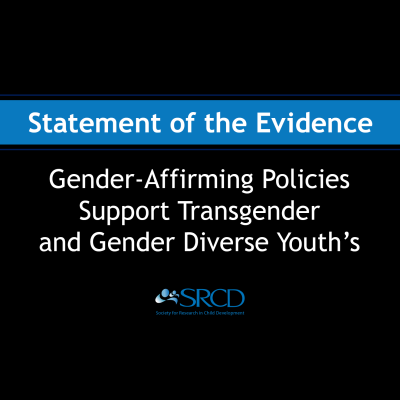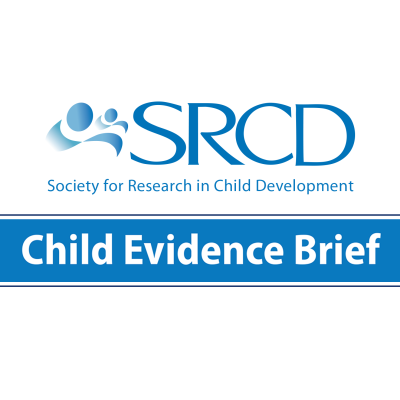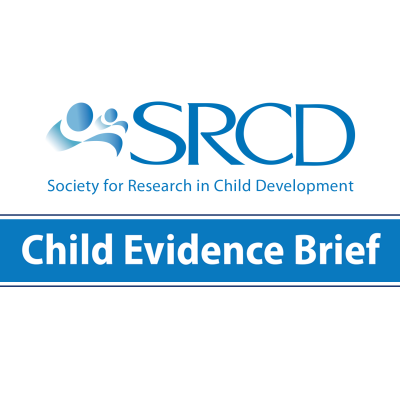Addressing Inequities in Education: Considerations for LGBTQ+ Children and Youth in the Era of COVID-19
Edited by Tiffany Yip, Ph.D., Fordham University. For more information, contact Kelly R. Fisher, Ph.D., Director for Policy, or Nighisti Dawit, M.Sc., Senior Policy Associate, Society for Research in Child Development, at policy@srcd.org.
Authors
- V. Paul Poteat, Ph.D., Boston College
- Robert A. Marx, Ph.D., San Jose State University
- Jerel P. Calzo, Ph.D., San Diego State University
- Russell B. Toomey, Ph.D., University of Arizona
- Caitlin Ryan, Ph.D., San Francisco State University
- Caitlin M. Clark, Ph.D., GLSEN
- Selin Gülgöz, Ph.D., Fordham University
Schools play a critical role in meeting the needs of children, youth, and families in times of crisis. During this pandemic, schools must plan for a new academic year in which many students will experience enduring trauma, food and housing insecurity, limited access to community resources, and uncertainty about future disruptions. Historically, schools have been settings of adversity for LGBTQ+ young people (lesbian, gay, bisexual, transgender, queer). During this pandemic, they face potentially amplified discrimination and barriers to education and healthcare access. Nevertheless, LGBTQ+ youth thrive when schools and families affirm and support them. We highlight adversities and strengths experienced by LGBTQ+ students in schools, the unique impact of COVID-19 on LGBTQ+ youth, and identify school policies and practices to support them. Schools will need to uphold protective policies, safeguard students’ LGBTQ+ identities, provide professional development and trauma-informed services, and connect LGBTQ+ students with school and community resources.
LGBTQ+ youth experience sources of adversity and strength in school and family settings, which have bearing on their well-being and academic needs.1,2 The adversities LGBTQ+ youth face could be exacerbated during the COVID-19 pandemic.3,4 Still, schools can foster resilience among LGBTQ+ youth and meet their unique needs.
LGBTQ+ Youth Who Face Harassment At School and Online Experience Negative Outcomes 2,5-7
LGBTQ+ students experience greater harassment than heterosexual and cisgender students, in school and online.1,8,9 They often do not report victimization, fearing that adults will be unresponsive.1,10 Yet, it is tied to elevated physical and mental health concerns.2,5-7 With remote instruction and physical distancing, LGBTQ+ youth use online spaces for schooling, socializing, and support.11,12 Online spaces have potential to promote their health through social-emotional support,13,14 but may also bring discrimination and harassment.15
Many LGBTQ+ Youth Experience Inequities Tied to Other Marginalized Identities
LGBTQ+ youth who experience multiple forms of marginalization (e.g., racism, xenophobia, income inequality) may face compounded barriers to healthcare and school access during the pandemic.1,16-19 Communities of color are disproportionately affected by COVID-1920 and face systemic discrimination and disparities (e.g., less accessible healthcare).21,22 Also, LGBTQ+ youth represent approximately 25% of youth experiencing unstable housing (e.g., living in a shelter or motel),23 making efforts to mitigate the spread of COVID-19 (e.g., physical distancing) and accessing online education difficult.
Gender-Affirming Healthcare Contributes to Better Health and Well-Being24,25
Prioritized medical services for COVID-19 have postponed gender-affirming medical care (e.g., puberty suppressants) for transgender and gender diverse youth,26 which can cause distress. Transgender and non-binary students also may have less access to school health professionals (e.g., school nurses, counselors) during this period. These professionals can help meet their social-emotional support needs.27,28 Gender affirmation in medical care and in schooling (e.g., using correct gender pronouns, supporting name changes on student records) remain important.
During periods of stay-at-home guidance, some LGBTQ+ youth have “re-closeted” and report distress due to fears of safety at home.
LGBTQ+ Youth Can Experience Heightened Risk of Family Rejection
A number of LGBTQ+ youth report rejection or harassment from caregivers and siblings.29,30 Thus, some LGBTQ+ youth do not disclose their identities to family members.31,32 During periods of stay-at-home guidance, some LGBTQ+ youth have “re-closeted” (i.e., avoided discussing or expressing their identities) and report distress due to fears of safety at home.4,33 LGBTQ+ individuals are also at elevated risk for child abuse and domestic violence,34,35 and may be unable to report them through traditional channels, like schools, during the pandemic.
Schools Often Provide Resources for LGBTQ+ Students and Their Families
LGBTQ+ supportive clubs are in 37% of U.S. secondary schools;36 their presence and students’ involvement in them is associated with better mental health.37,38 Also, 96.6% of LGBTQ+ students can identify an LGBTQ+-affirming adult at school; 61.0% can identify six or more.1 Students in schools with LGBTQ+-inclusive curricula and enumerated anti-bullying policies protecting LGBTQ+ students report greater safety and well-being.1,39-41 COVID-19 has forced schools to limit activities and resources otherwise provided for students. Support for such resources will be important when schools reopen.
Policy and Practice Implications
Schools can address the implications of the pandemic for LGBTQ+ youth by implementing inclusive policies and developmentally-informed practices and partnering with LGBTQ+-affirming organizations.
Uphold protective school policies and practices:
- Establish guidelines for respectful, affirming in-person and online interactions among students and school personnel; review school mission statements for inclusivity; infuse LGBTQ+ inclusive materials in course content.42-44
- Review and update anti-bullying and anti-discrimination policies and reporting procedures; update policies as needed to cover changing circumstances (e.g., applicability to remote instruction; processes for receiving, reviewing, and responding to student reports).
- Adopt enumerated policies protecting groups facing greater harassment, such as LGBTQ+ students.45
Safeguard the confidentiality of LGBTQ+ students’ identities:
- Share ways for students to protect their privacy and safety online and on social media.46,47
- Ask LGBTQ+ students about their desired support. When contacting caregivers, safeguard students’ LGBTQ+ identities when they are not “out” or fear rejection; ask students how and when to use their name and gender pronouns with others.48
Provide professional development and trauma-informed services:
- Offer continuing education for school personnel on LGBTQ+ students’ current concerns, effective support strategies, and implementing inclusive policies.42,49,50
- Communicate regularly with students; offer referrals to LGBTQ+-affirming agencies or health professionals for students with mental and physical health needs.
- Provide students with coping techniques and daily routines, such as check-ins and mindfulness exercises.51
Connect LGBTQ+ students with school and community resources:
- Encourage formation of LGBTQ+-affirming school clubs; offer them support and resources to connect students during periods of disruption.
- Identify school personnel trusted by LGBTQ+ youth who can maintain contact with them. Identify preferred, reliable, and secure communication methods with students.
- Provide LGBTQ+ students with access to school health professionals to address traumatic grief and loss.
- Direct students and families to community or online groups providing LGBTQ+ support and resources and confirm that school servers do not block access to relevant LGBTQ+-affirming websites. There are a number of reputable resources, some useful evidence-informed resources include GLSEN,52 Trevor Space,53;and the Family Acceptance Project.54
This brief is part of a larger volume that addresses the impact of systemic racism and the potential exacerbating effects of COVID-19 on racial-ethnic minority children, youth, and families, and LGBTQ+ youth. The full volume includes the following briefs:
- Considerations for American Indian and Alaska Native Children and Youth in the Era of COVID-19
- Considerations for Asian American Children and Youth in the Era of COVID-19
- Considerations for Black Children and Youth in the Era of COVID-19
- Considerations for Latinx Children and Youth in the Era of COVID-19
- Considerations for LGBTQ+ Children and Youth in the Era of COVID-19
Endnotes / References
(1) Kosciw, J. G., Greytak, E. A., Zongrone, A. D., Clark, C. M., & Truong, N. L. (2018). The 2017 national school climate survey: The experiences of lesbian, gay, bisexual, transgender, and queer youth in our nation's schools. GLSEN. https://www.glsen.org/sites/default/files/2019-10/GLSEN-2017-National-School-Climate-Survey-NSCS-Full-Report.pdf
(2) Russell, S. T., & Fish, J. N. (2016). Mental health in lesbian, gay, bisexual, and transgender (LGBT) youth. Annual Review of Clinical Psychology, 12, 465-487. https://doi.org/10.1146/annurev-clinpsy-021815-093153
(3) Neighmond, P. (2020, May 17). Home but not safe, some LGBTQ young people face rejection from families in lockdown. NPR. https://www.npr.org/sections/health-shots/2020/05/17/856090474/home-but-not-safe-some-lgbtq-young-people-face-rejection-from-families-in-lockdo
(4) Venkatraman, S. (2020, May 3). For LGBTQ youth, home might not be a safe place to self-isolate. NBC News. https://www.nbcnews.com/feature/nbc-out/lgbtq-youth-home-might-not-be-safe-place-self-isolate-n1181721
(5) Bouris, A., Everett, B. G., Heath, R. D., Elsaesser, C. E., & Neilands, T. B. (2016). Effects of victimization and violence on suicidal ideation and behaviors among sexual minority and heterosexual adolescents. LGBT Health, 3(2), 153-161. https://doi.org/10.1089/lgbt.2015.0037
(6) Burton, C. M., Marshal, M. P., Chisolm, D. J., Sucato, G. S., & Friedman, M. S. (2013). Sexual minority-related victimization as a mediator of mental health disparities in sexual minority youth: A longitudinal analysis. Journal of Youth and Adolescence, 42(3), 394-402. https://doi.org/10.1007/s10964-012-9901-5
(7) Russell, S. T., Ryan, C., Toomey, R. B., Diaz, R. M., & Sanchez, J. (2011). Lesbian, gay, bisexual, and transgender adolescent school victimization: Implications for young adult health and adjustment. Journal of School Health, 81(5), 223-230. https://doi.org/10.1111/j.1746-1561.2011.00583.x
(8) Poteat, V. P., Birkett, M., Turner, B., Wang, X., & Phillips, G., II (2020). Changes in victimization risk and disparities for heterosexual and sexual minority youth: trends from 2009 to 2017. Journal of Adolescent Health, 66, 202-209. https://doi.org/10.1016/j.jadohealth.2019.08.009
(9) Toomey, R. B., & Russell, S. T. (2013). The role of sexual orientation in school-based victimization: A meta-analysis. Youth & Society, 48(2), 176-201. https://doi.org/10.1177/0044118X13483778
(10) Berger, C., Poteat, V. P., & Dantas, J. (2017). Should I report? The role of general and sexual orientation-specific bullying policies and teacher behavior on adolescents’ reporting of victimization experiences. Journal of School Violence, 18(1), 107-120. https://doi.org/10.1080/15388220.2017.1387134
(11) Cromar, A. (2020, April 15). Queer and quarantined: Coronavirus challenges spark a resurgence in LGBTQ+ online communities. Boston. https://www.boston.com/news/local-news/2020/04/15/queer-and-quarantined-coronavirus-challenges-spark-a-resurgence-in-lgbtq-online-communities
(12) López, C. (2020, April 28). LGBTQ teens are cut off from support networks in quarantine, so they're building community online instead. Insider. https://www.insider.com/lgbtq-teens-are-building-community-online-while-quarantined-2020-4
(13) Evans, Y. N., Gridley, S. J., Crouch, J., Wang, A., Moreno, M. A., Ahrens, K., & Breland, D. J. (2017). Understanding online resource use by transgender youth and caregivers: A qualitative study. Transgender Health, 2(1), 129-139. https://doi.org/10.1089/trgh.2017.0011
(14) Ybarra, M. L., Mitchell, K. J., Palmer, N. A., & Reisner, S. L. (2014). Online social support as a buffer against online and offline peer and sexual victimization among U.S. LGBT and non-LGBT youth. Child Abuse & Neglect, 39, 123-136. https://doi.org/10.1016/j.chiabu.2014.08.006
(15) GLSEN, CiPHR, & CCRC. (2013). Out online: The experiences of lesbian, gay, bisexual and transgender youth on the Internet. GLSEN. https://www.glsen.org/sites/default/files/2020-01/Out_Online_Full_Report_2013.pdf
(16) Kuper, L. E., Coleman, B. R., & Mustanski, B. S. (2013). Coping with LGBT and racial-ethnic‐related stressors: A mixed‐methods study of LGBT youth of color. Journal of Research on Adolescence, 24(4), 703-719. https://doi.org/10.1111/jora.12079
(17) Russell, S. T., & Truong, N. L. (2001). Adolescent sexual orientation, race and ethnicity, and school environments: A national study of sexual minority youth of color. In K. K. Kumashiro (Ed.), Troubling intersections of race and sexuality: Queer students of color and anti-oppressive education (pp. 113-130). Rowman & Littlefield Publishers.
(18) Toomey, R. B., Huynh, V. W., Jones, S. K., Lee, S., & Revels-Macalinao, M. (2016). Sexual minority youth of color: A content analysis and critical review of the literature. Journal of Gay & Lesbian Mental Health, 21(1), 3-31. https://doi.org/10.1080/19359705.2016.1217499
(19) Chisholm, N. J. (2020, May 27). COVID-19’s impact on the Black LGBTQ+ community creates new traumas. Color Lines. https://www.colorlines.com/articles/covid-19s-impact-black-lgbtq-community-creates-new-traumas
(20) van Dorn, A., Cooney, R. E., & Sabin, M. L. (2020). COVID-19 exacerbating inequalities in the US. The Lancet, 395(10232), 1243-1244. https://doi.org/10.1016/S0140-6736(20)30893-X
(21) Williams, D. R., & Mohammed, S. A. (2008). Discrimination and racial disparities in health: Evidence and needed research. Journal of Behavioral Medicine, 32(1), 20-47. https://doi.org/10.1007/s10865-008-9185-0
(22) Hooper, M. W., Nápoles, A. M., & Pérez-Stable, E. J. (2020). COVID-19 and racial/ethnic disparities. JAMA, 323(24), 2466-2467. https://doi.org/10.1001/jama.2020.8598
(23) Baams, L., Wilson, B. D. M., & Russell, S. T. (2019). LGBTQ youth in unstable housing and foster care. Pediatrics, 143(3), e20174211. https://doi.org/10.1542/peds.2017-4211
(24) Rafferty, J., & Committee on Psychosocial Aspects of Child and Family Health, & Section on Lesbian, Gay, Bisexual, and Transgender Health and Wellness. (2018). Ensuring comprehensive care and support for transgender and gender-diverse children and adolescents. Pediatrics, 142(4), e20182162. https://doi.org/10.1542/peds.2018-2162
(25) Salas-Humara, C., Sequeira, G. M., Rossi, W., & Dhar, C. P. (2019). Gender affirming medical care of transgender youth. Current Problems in Pediatric and Adolescent Health Care, 49(9), 100683. https://doi.org/10.1016/j.cppeds.2019.100683
(26) Wang, Y., Pan, B., Liu, Y., Wilson, A., Ou, J., & Chen, R. (2020). Health care and mental health challenges for transgender individuals during the COVID-19 pandemic. The Lancet Diabetes & Endocrinology 8(7), 564-565. https://doi.org/10.1016/S2213-8587(20)30182-0
(27) Menkin, D., & Flores, D. D. (2018). Transgender students: Advocacy, care, and support opportunities for school nurses. NASN School Nurse, 34(3), 173-177. https://doi.org/10.1177/1942602X18801938
(28) Reisner, S. L., Sava, L. M., Menino, D. D., Perrotti, J., Barnes, T. N., Humphrey, D. L., Nikitin, R. V., & Earnshaw, V. A. (2020). Addressing LGBTQ student bullying in Massachusetts schools: Perspectives of LGBTQ students and school health professionals. Prevention Science, 21(3), 408-421. https://doi.org/10.1007/s11121-019-01084-4
(29) Ryan, C., Huebner, D., Diaz, R. M., & Sanchez, J. (2009). Family rejection as a predictor of negative health outcomes in White and Latino lesbian, gay, and bisexual young adults. Pediatrics, 123(1), 346-352. https://doi.org/10.1542/peds.2007-3524
(30) Ryan, C., Russell, S. T., Huebner, D., Diaz, R., & Sanchez, J. (2010). Family acceptance in adolescence and the health of LGBT young adults. Journal of Child and Adolescent Psychiatric Nursing, 23(4), 205-213. https://doi.org/10.1111/j.1744-6171.2010.00246.x
(31) Russell, S. T., Toomey, R. B., Ryan, C., & Diaz, R. M. (2014). Being out at school: The implications for school victimization and young adult adjustment. American Journal of Orthopsychiatry, 84(6), 635-643. https://doi.org/10.1037/ort0000037
(32) Watson, R. J., Wheldon, C. W., & Russell, S. T. (2015). How does sexual identity disclosure impact school experiences? Journal of LGBT Youth, 12(4), 385-396. https://doi.org/10.1080/19361653.2015.1077764
(33) Fish, J. N., McInroy, L. B., Paceley, M. S., Williams, N. D., Henderson, S., Levine, D. S., & Edsall, R. N. (2020). “I’m kinda stuck at home with unsupportive parents right now”: LGBTQ+ youths’ experiences with COVID-19 and the importance of online support. Journal of Adolescent Health, 67(3), 450-452. https://doi.org/10.1016/j.jadohealth.2020.06.002
(34) Friedman, M. S., Marshal, M. P., Guadamuz, T. E., Wei, C., Wong, C. F., Saewyc, E. M., & Stall, R. (2011). A meta-analysis of disparities in childhood sexual abuse, parental physical abuse, and peer victimization among sexual minority and sexual nonminority individuals. American Journal of Public Health, 101(8), 1481-1494. https://doi.org/10.2105/ajph.2009.190009
(35) McKay, T., Lindquist, C. H., & Misra, S. (2017). Understanding (and acting on) 20 years of research on violence and LGBTQ+ communities. Trauma, Violence, & Abuse, 20(5), 665-678. https://doi.org/10.1177/1524838017728708
(36) Brener, N. D., Smith-Grant, J., McManus, T., Shanklin, S. L., & Underwood, J. M. (2019). School health profiles 2018: Characteristics of health programs among secondary schools. Centers for Disease Control and Prevention. https://stacks.cdc.gov/view/cdc/82686
(37) Marx, R. A., & Kettrey, H. H. (2016). Gay-straight alliances are associated with lower levels of school-based victimization of LGBTQ+ youth: A systematic review and meta-analysis. Journal of Youth and Adolescence, 45(7), 1269-1282. https://doi.org/10.1007/s10964-016-0501-7
(38) Poteat, V. P., Calzo, J. P., Yoshikawa, H., Lipkin, A., Ceccolini, C. J., Rosenbach, S. B., O’Brien, M. D., Marx, R. A., Murchison, G. R., & Burson, E. (2019). Greater engagement in Gender-Sexuality Alliances (GSAs) and GSA characteristics predict youth empowerment and reduced mental health concerns. Child Development. Advance online publication. https://doi.org/10.1111/cdev.13345
(39) Day, J. K., Ioverno, S., & Russell, S. T. (2019). Safe and supportive schools for LGBT youth: Addressing educational inequities through inclusive policies and practices. Journal of School Psychology, 74, 29-43. https://doi.org/10.1016/j.jsp.2019.05.007
(40) Gower, A. L., Forster, M., Gloppen, K., Johnson, A. Z., Eisenberg, M. E., Connett, J. E., & Borowsky, I. W. (2017). School practices to foster LGBT-supportive climate: Associations with adolescent bullying involvement. Prevention Science, 19(6), 813-821. https://doi.org/10.1007/s11121-017-0847-4
(41) Kull, R. M., Greytak, E. A., Kosciw, J. G., & Villenas, C. (2016). Effectiveness of school district antibullying policies in improving LGBT youths’ school climate. Psychology of Sexual Orientation and Gender Diversity, 3(4), 407-415. https://doi.org/10.1037/sgd0000196
(42) Centers for Disease Control and Prevention. (n.d.). LGBT youth resources. https://www.cdc.gov/lgbthealth/youth-resources.htm
(43) GLSEN. (n.d.). Developing LGBTQ-inclusive classroom resources. https://www.glsen.org/activity/inclusive-curriculum-guide
(44) Poteat, V. P., DiGiovanni, C. D., & Scheer, J. R. (2012). Predicting homophobic behavior among heterosexual youth: Domain general and sexual orientation-specific factors at the individual and contextual level. Journal of Youth and Adolescence, 42(3), 351-362. https://doi.org/10.1007/s10964-012-9813-4
(45) GLSEN. (n.d.). School district policy. https://www.glsen.org/district-policy
(46) Federal Trade Commission. (2011, September). Kids and socializing online. https://www.consumer.ftc.gov/articles/0012-kids-and-socializing-online
(47) National Cybersecurity Alliance. (n.d.). Privacy tips for teens. https://staysafeonline.org/stay-safe-online/managing-your-privacy/privacy-tips-teens/
(48) GLSEN. (2020). Pronoun guide. https://www.glsen.org/sites/default/files/2020-03/GLSEN_PronounsResource_2020_Final.pdf
(49) GLSEN. (n.d.). Webinars and workshops. https://www.glsen.org/resources/webinars-and-workshops
(50) Human Rights Campaign. (n.d.). All children - all families: Tips for successful LGBTQ staff training efforts. https://www.hrc.org/resources/all-children-all-families-tips-for-successful-lgbtq-staff-training-efforts
(51) Romero, V. E., Robertson, R., & Warner, A. N. (2018). Building resilience in students impacted by adverse childhood experiences: A whole-staff approach. Corwin. https://us.corwin.com/en-us/nam/building-resilience-in-students-impacted-by-adverse-childhood-experiences/book260339
(52) GLSEN. (n.d.). GLSEN. https://www.glsen.org/
(53) TrevorSpace. (n.d.). TrevorSpace. https://www.trevorspace.org/
(54) Family Acceptance Project. (n.d.). San Francisco State University. https://familyproject.sfsu.edu/


